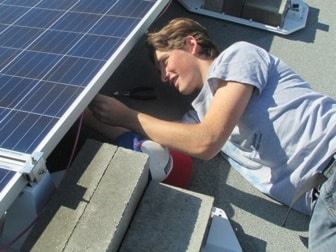Students from Nakusp Secondary School and Lucerne Elementary Secondary School in New Denver got a hands-on experience installing solar panels during the week of Oct.19.
School district 10 applied for the Carbon Neutral Capital Planning grant, from the Ministry of Education. They received $50,000 in grant money and matched it, bringing the total to $100,000.
It was decided the money would be implemented in installing solar panels on the roofs of Nakusp Elementary School (NES) and Lucerne Elementary Secondary School.
An announcement was made over the PA system at NSS for students who might be interested in installing solar panels on the roofs of NES and Lucerne. Four were chosen in total.
Angus Jackson, a student at NSS, was one of those four.
“I thought it might be interesting, so I asked her about it,” he said. “They needed people to do it, so they got me right on it.”
Students went through half a day in the classroom learning about what they would be doing, and then they got right to work.
“We budgeted for the installation for a week with the students,” said Art Olson, manager of operations and transportation for School District 10. “Nakusp Elementary was supposed to take two days, Monday to Tuesday evening. We finished wrapping up, cleaning up garbage at 11:30 Tuesday morning. Quick learners make it fast.”
Olson is very pleased with the four students.
“They’ve been excellent, they’re very eager. They’re hands on. They want to learn, they’re good students,” he said.
The school district hired Home Energy Solutions (HES) to help them put together an application for the grant along with doing a study of what could be done on the roofs of the two schools.
In total, 48 solar panels were installed at NES, and 132 at Lucerne. Each panel can generate around 265 watts. This will generate about 15,000 kilowatt hours of solar energy for NES and about 35,000 for Lucerne. This is the equivalent of about six homes.
It is expected the schools will run entirely on solar power during the summer months. Because there are no students in the school during this time, there isn’t really a big draw for power. This means the schools could wind up generating excess.
What happens to that excess?
The power is monitored through B.C. Hydro net metering program. If power is not used in the buildings, it goes out to the grid and a credit is given. This credit can be used in subsequent months.
“Say they were always generating more than they needed in the summer, which might be the case, they’ll build up a credit on their bill that they can use in the winter months.” Said Ed Knaggs, an electrical engineer with HESPV.
The students aren’t just getting the knowledge and hands-on experience with this. They’re also getting volunteer hours. These volunteer hours are necessary if they wish to graduate.
The students will receive a certificate on solar installation. There is talk of having them do a fall restraint course online, to which they will also get a certificate. They will have the chance to put on their future resumes that they’ve worked with the school district on solar applications, which could help them down the road.
The group is still waiting for material currently on backorder. Because of this, the system isn’t yet up and running. It is expected the material will get to the schools and be installed within two weeks.
